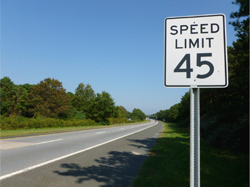FOR A FREE CONSULTATION
Laser
Laser guns, also known as lidar are used by the police to measure distance and calculate speed by comparing the change in distance during a specific amount of time. Fighting speeding ticket involving a laser is more difficult than a ticket based on a pace or radar.
The laser gun has a sight which the officer looks through at the target. The officer aims the device and pulls the trigger. When the trigger is pulled, the gun will produce a thin beam of visible infra-red light. This beam is emitted in pulses. As the distance to the vehicle being lasered increases, so does the diameter of the beam. At about 1000 feet, the diameter of the beam will be about 3 or 4 feet.
When the beam from the laser gun hits a relatively perpendicular, reflective surface on a vehicle, the beam bounces back toward the laser gun. Usually the officer will testify that he aimed the device at the license plate. By measuring how long it takes the beam to hit the vehicle and then return, the laser gun calculates the distance. By doing this multiple times the laser calculates the change in distance from one pulse to the next, and is able to calculate the speed of the vehicle.
The appeal of the laser to law enforcement is unlike radar which cannot reliably distinguish one vehicle from another in moderate to heavy traffic, the laser can specifically target one vehicle at a time. The disadvantage of laser is that it cannot be used while in motion.
Trying a speeding ticket involving laser is complex and technical, so it almost always makes sense to hire an attorney to represent you properly.
Some considerations at trial include
- Was the laser checked and calibrated before being used that day?
- Did the officer laser through the window or with the window down? Shooting the laser beam through glass diminishes its accuracy.
- What was the weather conditions like? Rain or snow can throw off the laser as the beam may reflect off of it.
- What were the traffic conditions like? Is it possible that the officer lasered another vehicle?
- Was the laser gun held steady? In order for the laser to work properly, the laser gun must be stationary.
- How far was the officer from the vehicle being lasered?
- At trial the officer must testify to his training and expertise. He must establish his expertise.
- At trial the officer must testify that he made a visual estimate before he lasered the vehicle and the officer must state what the visual estimate was.
- Ask the officer if he know what the plus or minus is on a laser. He officer should respond that the laser is accurate to plus or minus one mile per hour.



